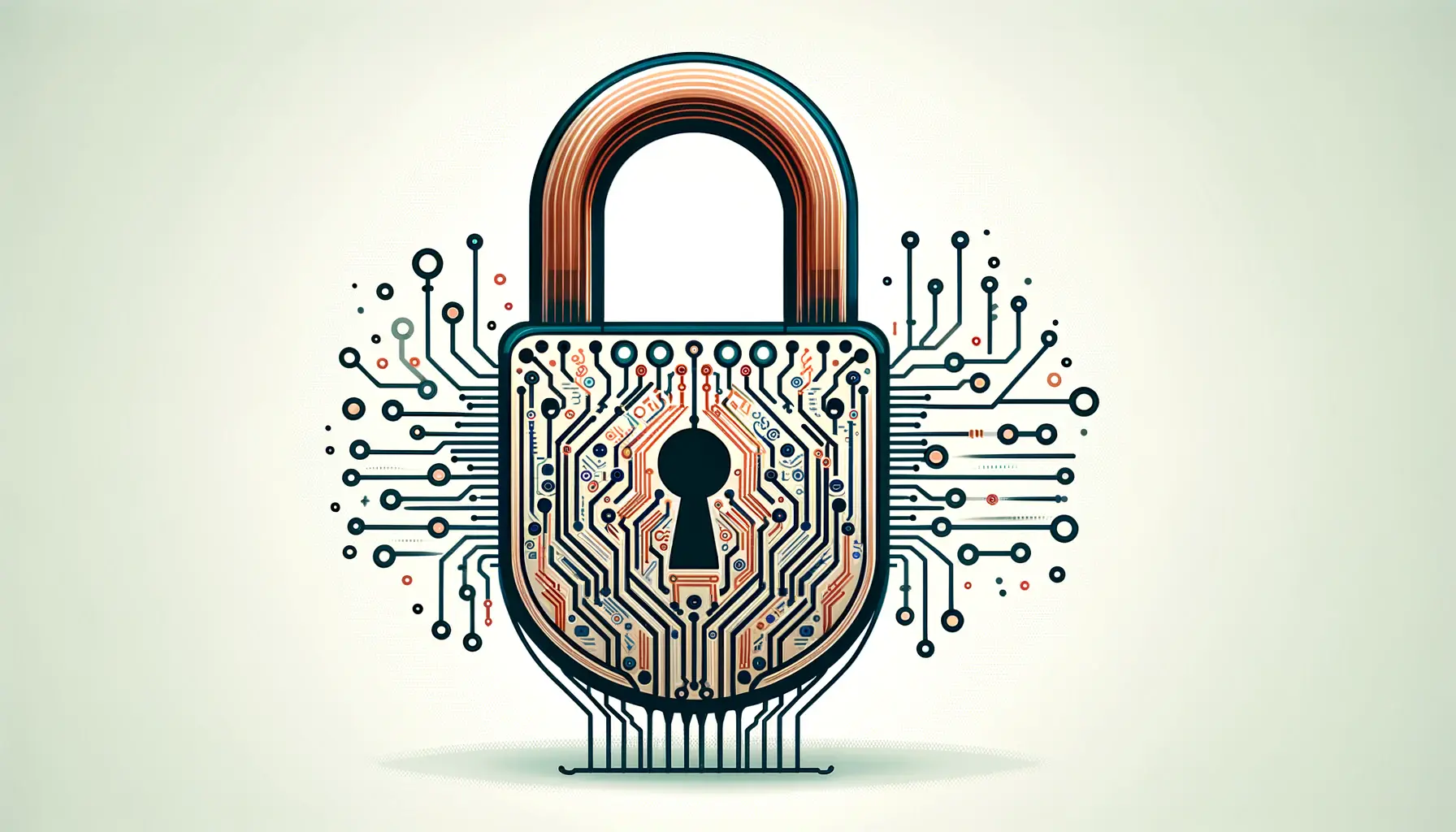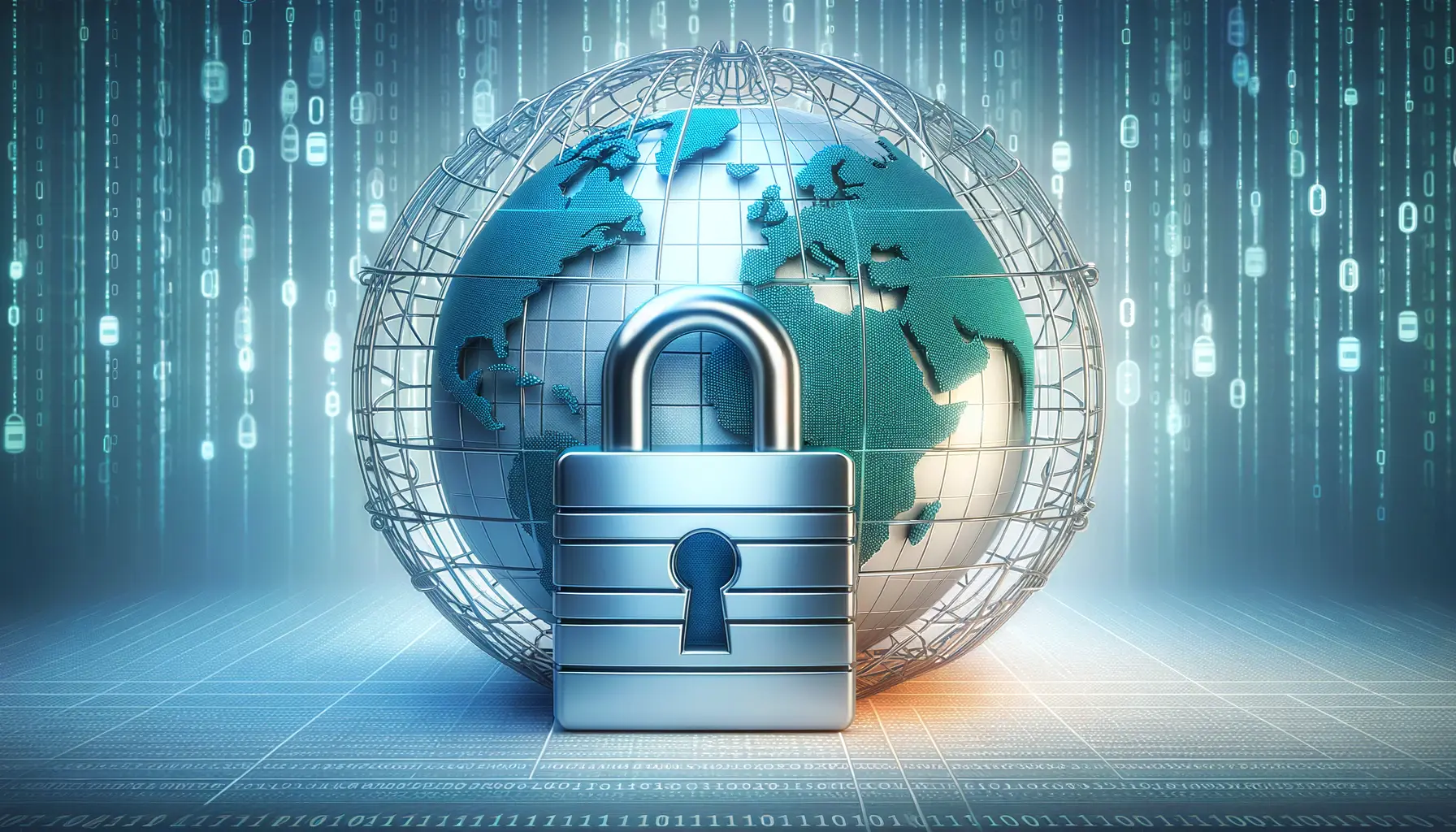In the rapidly evolving landscape of artificial intelligence, the advent of ChatGPT 4 has marked a significant milestone in how we interact with machine learning technologies.
This iteration of the generative pre-trained transformer model has not only enhanced the way we generate text but has also brought to the forefront the critical issue of data security.
As we delve deeper into the capabilities of ChatGPT 4, it becomes imperative to understand the mechanisms it employs to safeguard sensitive information and ensure privacy.
The integration of ChatGPT 4 into various sectors, from customer service to content creation, has underscored the importance of robust data protection strategies.
The model’s ability to process and generate human-like text based on vast amounts of data raises valid concerns regarding data privacy and security.
This article aims to explore the multifaceted approach to securing data within the framework of ChatGPT 4, highlighting the innovative solutions and practices that have been developed to address these concerns.
- Understanding Data Security in ChatGPT 4
- Challenges in Data Security with ChatGPT 4
- Best Practices for Data Security with ChatGPT 4
- Implementing Access Control and Authentication
- Enhancing Data Privacy with ChatGPT 4
- Future Directions in Data Security for ChatGPT 4
- Developing a Culture of Security Awareness
- Conclusion: Navigating the Future of Data Security with ChatGPT 4
- FAQs on Securing Data with ChatGPT 4
Understanding Data Security in ChatGPT 4
The Foundation of Data Security in AI
Data security in artificial intelligence, particularly in models like ChatGPT 4, is built on a foundation of ethical data use, encryption, and user consent.
The architecture of ChatGPT 4 is designed to handle data in a way that minimizes risks and ensures that user information is processed securely.
By employing advanced encryption methods, ChatGPT 4 ensures that data, both at rest and in transit, is protected against unauthorized access and breaches.
Moreover, the principle of user consent is paramount in the operation of ChatGPT 4.
Users have the control to manage their data, deciding what information can be used by the model.
This level of autonomy is crucial in building trust and ensuring that the interaction with ChatGPT 4 remains secure and within the boundaries of user expectations.
Strategies for Enhancing Data Security
To fortify data security, ChatGPT 4 incorporates several strategies that are pivotal in safeguarding user information.
One such strategy is the anonymization of data, where personally identifiable information is removed or altered to prevent the tracing back to an individual.
This process is essential in reducing the risks associated with data breaches and ensuring privacy.
Another key strategy is the implementation of robust access controls and authentication mechanisms.
These controls are designed to limit access to sensitive data, ensuring that only authorized personnel can interact with the system.
By leveraging advanced authentication methods, such as two-factor authentication, ChatGPT 4 adds an extra layer of security, significantly reducing the potential for unauthorized access.
Implementing advanced encryption, user consent protocols, data anonymization, and stringent access controls are fundamental in securing data within ChatGPT 4.
Challenges in Data Security with ChatGPT 4
The integration of ChatGPT 4 into diverse applications brings forth unique challenges in ensuring data security.
As the technology processes vast amounts of information, identifying and mitigating potential vulnerabilities becomes crucial.
This part of the article explores the primary challenges faced in securing data within ChatGPT 4 and the implications for users and developers alike.
Identifying Potential Vulnerabilities
One of the foremost challenges is the identification of potential vulnerabilities within the system.
As with any complex software, ChatGPT 4 is susceptible to various security threats, including data breaches, phishing attacks, and other forms of cyber exploitation.
The dynamic nature of AI and machine learning models further complicates this issue, as new vulnerabilities can emerge as the technology evolves.
- Data Breaches: Unauthorized access to sensitive data can lead to significant privacy violations and financial losses.
- Phishing Attacks: Sophisticated phishing schemes using AI-generated content can trick users into divulging sensitive information.
- Exploitation of Vulnerabilities: Hackers may exploit unknown vulnerabilities within the system, compromising data integrity and user privacy.
Ensuring User Privacy and Trust
Maintaining user privacy and trust is another significant challenge.
As users interact with ChatGPT 4, they entrust the system with sensitive information, expecting that their data will be handled securely.
Ensuring the confidentiality and integrity of this information is paramount to maintaining user trust and the overall success of the technology.
- Confidentiality: Protecting the confidentiality of user data to prevent unauthorized access and disclosure.
- Integrity: Ensuring the accuracy and completeness of data throughout its lifecycle.
- Transparency: Providing users with clear information about how their data is used and processed.
Compliance with Data Protection Regulations
Complying with international data protection regulations poses yet another challenge.
Regulations such as the General Data Protection Regulation (GDPR) in the European Union and the California Consumer Privacy Act (CCPA) in the United States set strict guidelines for data handling and privacy.
Adhering to these regulations requires continuous monitoring and updates to the system to ensure compliance.
- GDPR Compliance: Implementing measures to comply with the GDPR’s requirements for data protection and user rights.
- CCPA Compliance: Ensuring that data handling practices align with the CCPA’s provisions for consumer privacy.
- Global Data Protection: Navigating the complexities of complying with various international data protection laws.
Addressing these challenges requires a proactive approach, focusing on continuous improvement and adaptation of security measures to protect against evolving threats.
Best Practices for Data Security with ChatGPT 4
To navigate the challenges of securing data in ChatGPT 4, adopting best practices is essential.
These practices not only help in mitigating risks but also ensure that the system remains robust against potential threats.
This section outlines the key strategies and measures that can be employed to enhance data security when interacting with ChatGPT 4.
Implementing Strong Encryption Techniques
One of the foundational steps in securing data is the use of strong encryption techniques.
Encryption serves as the first line of defense, ensuring that data, whether at rest or in transit, is unreadable to unauthorized parties.
Employing advanced encryption standards like AES (Advanced Encryption Standard) and TLS (Transport Layer Security) for data transmission can significantly reduce the risk of data breaches.
- Use AES for encrypting stored data.
- Implement TLS for secure data transmission.
Regular Security Audits and Vulnerability Assessments
Conducting regular security audits and vulnerability assessments is crucial in identifying potential weaknesses in the system.
These assessments allow for the timely detection and remediation of vulnerabilities, thereby preventing exploitation by malicious actors.
- Schedule periodic security audits to evaluate the effectiveness of current security measures.
- Perform vulnerability assessments to identify and address potential security gaps.
Adhering to Data Minimization Principles
Data minimization is a key principle in data protection, advocating for the collection and processing of only the data that is necessary for a specific purpose.
By limiting the amount of data collected and stored, the risk of data breaches and privacy violations can be significantly reduced.
- Collect only the data that is necessary for the intended purpose.
- Limit the retention of data to the minimum necessary duration.
Enhancing User Control and Consent Mechanisms
Empowering users with control over their data and ensuring transparent consent mechanisms are vital for maintaining trust.
Users should be able to easily manage their data preferences, including the ability to opt-out of data collection and processing.
- Provide clear and accessible options for users to manage their data preferences.
- Ensure that consent mechanisms are transparent and easily understandable.
Incorporating these best practices into the deployment and operation of ChatGPT 4 can significantly enhance data security, ensuring a safer environment for both users and developers.
Implementing Access Control and Authentication
Access control and authentication mechanisms play a crucial role in securing data within ChatGPT 4.
These systems ensure that only authorized users can access sensitive information, thereby reducing the risk of unauthorized data exposure.
Implementing robust access control and authentication strategies is essential for maintaining the security and integrity of data.
Role-Based Access Control (RBAC)
Role-Based Access Control (RBAC) is a method of restricting system access to authorized users based on their roles within an organization.
RBAC helps in minimizing the risk of unauthorized access by ensuring that users can only access the information necessary for their job functions.
- Define roles and permissions based on job functions.
- Assign users to roles rather than granting permissions directly to individuals.
Multi-Factor Authentication (MFA)
Multi-Factor Authentication (MFA) adds an additional layer of security by requiring users to provide two or more verification factors to gain access to a system.
MFA is an effective deterrent against unauthorized access, as it makes it significantly more challenging for attackers to compromise user accounts.
- Implement MFA for all user accounts, especially those with access to sensitive data.
- Use a combination of something the user knows (password), something the user has (security token), and something the user is (biometric verification).
Continuous Monitoring and Anomaly Detection
Continuous monitoring of user activities and the implementation of anomaly detection systems are vital for identifying and responding to unauthorized access attempts.
These systems can alert administrators to suspicious activities, enabling timely intervention to prevent data breaches.
- Deploy monitoring tools to track user activities and access patterns.
- Implement anomaly detection systems to identify unusual access attempts or data usage patterns.
Secure API Integration
When integrating ChatGPT 4 with other systems through APIs, ensuring the security of these connections is paramount.
Secure API integration involves implementing measures to protect against unauthorized access and data breaches, such as using API keys and OAuth tokens.
- Use API keys and OAuth tokens to authenticate and authorize API requests.
- Regularly rotate API keys and tokens to minimize the risk of compromise.
Effective access control and authentication mechanisms are fundamental to securing data in ChatGPT 4, ensuring that only authorized users can access sensitive information and systems.
Enhancing Data Privacy with ChatGPT 4
As the capabilities of ChatGPT 4 continue to evolve, enhancing data privacy becomes a paramount concern.
Ensuring that user data is not only secure but also handled with the utmost respect for privacy is essential.
This part of the article delves into the measures and technologies that can be employed to enhance data privacy when interacting with ChatGPT 4.
Privacy by Design
Privacy by Design is a concept that calls for privacy to be taken into account throughout the whole engineering process.
This approach involves integrating privacy controls and considerations into the development and operation of ChatGPT 4, ensuring that privacy is not an afterthought but a foundational component.
- Embed privacy controls directly into the design and architecture of ChatGPT 4.
- Conduct privacy impact assessments to identify potential risks and mitigate them before they become issues.
Data Anonymization and Pseudonymization
Data anonymization and pseudonymization are techniques used to protect personal information by removing or altering identifiers that can link data to an individual.
These methods are particularly useful in reducing privacy risks associated with data processing and storage.
- Implement data anonymization to remove identifying details from data sets.
- Use pseudonymization to replace identifiers with pseudonyms, allowing data to be matched without revealing the actual identities.
User Consent and Data Management
User consent is a critical aspect of data privacy, ensuring that individuals have control over their personal information.
ChatGPT 4 should provide users with clear and concise information about how their data is used, along with the ability to manage their consent preferences easily.
- Offer transparent consent mechanisms that inform users about the use of their data.
- Provide users with tools to manage their data preferences, including options to withdraw consent and delete their data.
Compliance with Global Privacy Regulations
Adhering to global privacy regulations such as GDPR and CCPA is crucial for ensuring that ChatGPT 4 operates within legal boundaries.
Compliance involves implementing measures to protect user data according to the principles and requirements of these regulations.
- Ensure that data handling practices are in line with GDPR, CCPA, and other relevant privacy laws.
- Regularly update privacy policies and practices to reflect changes in legislation and industry standards.
Adopting a comprehensive approach to data privacy, including Privacy by Design, data anonymization, user consent management, and regulatory compliance, is essential for safeguarding user data in ChatGPT 4.
Future Directions in Data Security for ChatGPT 4
The landscape of data security and privacy is constantly evolving, with new challenges and solutions emerging as technology advances.
Looking towards the future, it’s essential to consider the directions in which data security for ChatGPT 4 might evolve.
This part explores potential advancements and innovations that could further enhance the security and privacy of data processed by ChatGPT 4.
Advancements in Encryption Technologies
As computational power increases, so does the need for more sophisticated encryption technologies.
Future advancements may include quantum-resistant encryption algorithms to safeguard against the potential threat posed by quantum computing.
These new forms of encryption will ensure that data remains secure even as the landscape of cyber threats evolves.
- Development of quantum-resistant encryption algorithms.
- Adoption of next-generation encryption standards for enhanced data protection.
AI and Machine Learning in Cybersecurity
The integration of AI and machine learning technologies into cybersecurity practices offers promising avenues for enhancing data security.
These technologies can be used to predict and identify potential threats more efficiently, enabling proactive rather than reactive security measures.
- Utilization of AI for real-time threat detection and response.
- Machine learning algorithms to predict and mitigate potential security vulnerabilities.
Decentralized Data Management
Decentralized data management systems, such as blockchain technology, offer a novel approach to securing data.
By distributing data across a network, rather than storing it in a central location, the risk of large-scale data breaches can be significantly reduced.
This approach also enhances data transparency and integrity.
- Implementation of blockchain technology for secure, decentralized data storage.
- Enhanced data integrity and transparency through distributed ledger technologies.
Enhanced Regulatory Frameworks
As technology continues to advance, regulatory frameworks will need to evolve to address new challenges in data security and privacy.
Future regulations may focus on more stringent data protection measures, increased transparency requirements, and enhanced user control over personal data.
- Development of more comprehensive data protection regulations.
- Increased emphasis on transparency and user control in data handling practices.
Exploring these future directions in data security for ChatGPT 4 highlights the importance of continuous innovation and adaptation in the face of evolving cyber threats and technological advancements.
Developing a Culture of Security Awareness
In the realm of data security and privacy, technology alone cannot safeguard against all potential threats.
A strong culture of security awareness among users and developers plays a crucial role in enhancing the overall security posture of systems like ChatGPT 4.
This final section explores the importance of fostering a culture of security awareness and the steps that can be taken to achieve this goal.
Education and Training
At the core of developing a culture of security awareness is the continuous education and training of all stakeholders involved.
Regular training sessions, workshops, and awareness campaigns can equip users and developers with the knowledge needed to identify and mitigate security risks effectively.
- Implement ongoing security training programs for employees and users.
- Conduct workshops on the latest security threats and best practices.
Encouraging Proactive Security Behaviors
Encouraging proactive security behaviors is essential for preventing security incidents before they occur.
This involves promoting practices such as regular password updates, cautious handling of suspicious emails, and the use of secure connections.
- Promote the use of strong, unique passwords and regular password changes.
- Advocate for the cautious handling of emails and links from unknown sources.
Building a Responsive Security Community
A responsive security community can significantly enhance the detection and response to security threats.
By fostering an environment where users and developers can easily report vulnerabilities and share information on emerging threats, the community can act as a powerful defense mechanism.
- Establish channels for reporting security concerns and vulnerabilities.
- Create forums or groups for sharing security tips and discussing potential threats.
Embedding Security into Organizational Culture
Finally, embedding security into the organizational culture ensures that security considerations are an integral part of every decision and process.
This approach not only enhances the security of data and systems but also builds a strong foundation of trust with users.
- Integrate security practices into daily workflows and decision-making processes.
- Ensure leadership demonstrates a commitment to security, setting a positive example for the entire organization.
Cultivating a culture of security awareness is a multifaceted effort that requires the active participation of everyone involved with ChatGPT 4. Through education, proactive behaviors, community engagement, and organizational commitment, the security and privacy of data can be significantly enhanced.
Conclusion: Navigating the Future of Data Security with ChatGPT 4
The journey through the intricacies of securing data with ChatGPT 4 has illuminated the multifaceted challenges and innovative solutions that define this dynamic field.
As we stand on the brink of new technological advancements, the importance of robust data security measures has never been more pronounced.
The evolution of ChatGPT 4 not only showcases the potential of AI in enhancing our digital experiences but also underscores the critical need for vigilance and proactive measures in protecting sensitive information.
Key Takeaways for Strengthening Data Security
In reflecting on the insights gathered, several key takeaways emerge as foundational pillars for strengthening data security in the era of ChatGPT 4:
- The adoption of advanced encryption techniques and access control mechanisms is essential for safeguarding data against unauthorized access.
- Implementing a culture of security awareness across all levels of interaction ensures a proactive stance against potential threats.
- Continuous innovation in cybersecurity measures, including the exploration of AI and machine learning, is crucial for staying ahead of evolving cyber threats.
- Adherence to global privacy regulations and the principles of data minimization and user consent underpins the ethical handling of user data.
As we navigate the complexities of data security in the context of ChatGPT 4, it becomes clear that a balanced approach, integrating technological solutions with human-centric strategies, is paramount.
The future of data security with ChatGPT 4 is not solely dependent on the advancements in encryption or AI-driven cybersecurity measures but also on the collective effort to foster a secure digital ecosystem.
Embracing the Future with Confidence
The path forward requires a concerted effort from developers, users, and regulatory bodies to embrace the challenges and opportunities presented by ChatGPT 4.
By fostering an environment of continuous learning, innovation, and collaboration, we can ensure that the benefits of ChatGPT 4 are realized without compromising the security and privacy of data.
The future of data security with ChatGPT 4 is a journey of ongoing adaptation and vigilance, but with the right measures in place, we can navigate this landscape with confidence and optimism.
FAQs on Securing Data with ChatGPT 4
Explore common queries about enhancing data security in the era of ChatGPT 4.
ChatGPT 4 employs encryption, anonymization, and user consent protocols to safeguard data privacy effectively.
ChatGPT 4 processes data based on user inputs and settings, emphasizing user control over personal data access.
Users should utilize strong passwords, enable two-factor authentication, and manage chat history settings for enhanced security.
ChatGPT 4 is designed to comply with GDPR and other privacy regulations, ensuring lawful and ethical data handling.
In the event of a data breach, ChatGPT 4 implements prompt measures to mitigate impacts and secure user data.
Yes, users have the option to delete their data or adjust settings to prevent data retention by ChatGPT 4.
ChatGPT 4 leverages AI for threat detection, anomaly identification, and to automate security protocols efficiently.
Future advancements may include quantum-resistant encryption and more sophisticated AI-driven cybersecurity measures.












